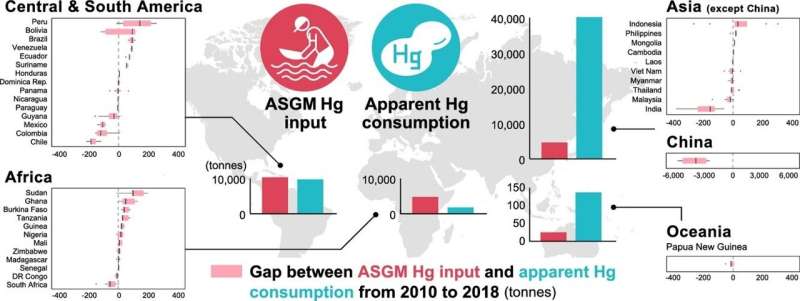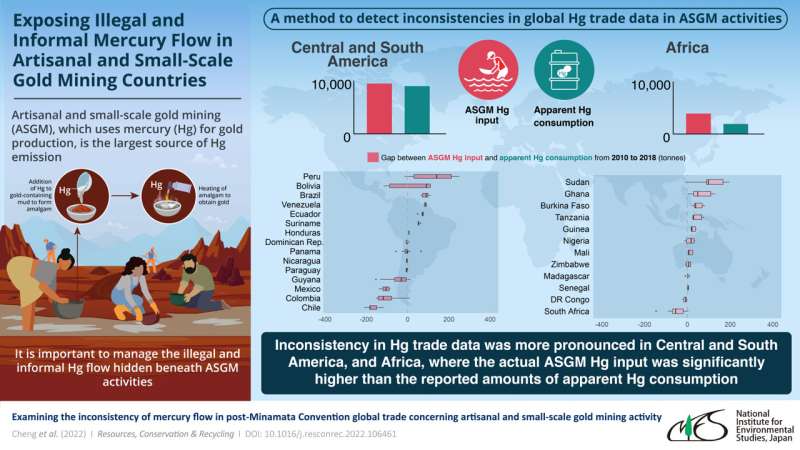New approach to exposing illegal and informal mercury trading

The Minamata Convention (MC) aims to restrict and limit the trading of mercury, a highly toxic pollutant. While most countries involved in artisanal and small-scale gold mining (ASGM), the biggest source of mercury pollution, are MC parties, its efficacy has remained unclear. Researchers have now developed a new method of examining global mercury trade data inconsistencies based on estimating and comparing the mercury input of ASGM activities to the total mercury available domestically (Fig.1).
Mercury (Hg) emissions are extremely toxic and can have broad and long-term effects on human health. Hg can accumulate in soil and water bodies, and can enter the food web through staple crops such as rice and seafood. The biggest source of Hg emissions is the artisanal and small-scale gold mining (ASGM) industry, which involves gold mining conducted by miners or enterprises with limited investment and production, and uses Hg to amalgamate gold ores.
In light of this, the Minamata Convention (MC) on Hg control came into effect in 2017 with the aim to put a stop to the trade and domestic production of mercury. The MC requires its signatories to stop all trade in metallic Hg, restrict the opening of new primary Hg mines, stop domestic Hg production by 2032, and stop the production and trade of Hg-added products (such as thermometers and Hg-vapor lamps) by 2020.
While 137 countries are currently parties to the MC, its efficacy has remained under question. Inconsistencies often exist in global trade data and lead to difficulties in Hg control and the evaluation of the MC. While the supply chains for the ASGM sector are heavily restricted and dried up, the demand for Hg may not have decreased. This gap in supply and demand could spawn informal or illegal Hg trading routes, such as mislabeling, smuggling, and black-market trade.
Against this backdrop, an international team of researchers from Japan, Chile, and Canada have now investigated this issue in depth. In their study, which was published in the journal Resources, Conservation and Recycling, the team investigated the effect of the MC on the global Hg flow using a method to detect inconsistencies in mercury flow data.
Their method of examining global Hg trade data inconsistencies is based on estimating the Hg input (the Hg that enters the amalgamation process and is lost with tailings and amalgam burning) of countries with ASGM activities and comparing this input amount to the total Hg available domestically (apparent Hg consumption). "By searching for Hg flows that changed significantly after the MC came into force, we can screen out trade routes of interest. This not only helps us see which trade activities have stopped or decreased but also highlights potentially illegal and informal mercury use flows that have appeared post-MC," explains Dr. Cheng.

The study was performed in 39 countries across four regions. The team identified inconsistencies in Hg trade statistics in African, Central and South American, and some Asian countries (Fig.2). Countries that are parties to the MC showed reduced metallic Hg trade, and those with national action plans (NAP) demonstrated clear active steps towards controlling Hg flow. "Our results highlight the importance of managing global Hg flows hidden beneath ASGM activities to enforce a sound Hg management. We believe that devising and implementing NAPs are an important step in this direction," notes Dr. Nakajima.
Asian countries, however, lagged behind other regions concerning the reduction in Hg trade. While some downturn in Hg export was observed, new import flows of commodities with high Hg content were found to have emerged since 2017.
Controlling Hg flow for the ASGM industry is critical for safe Hg management. While inconstancies in trade data make it difficult, this new method helps alleviate most of these issues and ensures that nations spend their resources more effectively on targeting and exposing high-risk trade routes and practices. Such advances in Hg management will reduce human exposure to mercury, allowing people to not only obtain clean gold more easily but also lead better lives.
More information: Yingchao Cheng et al, Examining the inconsistency of mercury flow in post-Minamata Convention global trade concerning artisanal and small-scale gold mining activity, Resources, Conservation and Recycling (2022). DOI: 10.1016/j.resconrec.2022.106461
Provided by National Institute for Environmental Studies



















